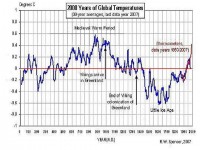By Sherwood, Keith and Craig Idso, CO2 Science Magazine
In an important paper recently published in the peer-reviewed journal Climatic Change, Swiss scientists Jan Esper (of the Swiss Federal Research Institute) and David Frank (of the Oeschger Centre for Climate Change Research) take the Intergovernmental Panel on Climate Change (IPCC) to task for concluding in their fourth assessment report (AR4) that, relative to modern times, there was “an increased heterogeneity of climate during medieval times about 1000 years ago.”
This finding, if true, would be of great significance to the ongoing debate over the cause of 20th-century global warming, because, in the words of Esper and Frank, “heterogeneity alone is often used as a distinguishing attribute to contrast with present anthropogenic warming.” On the other hand, if the IPCC’s contention is false, it would mean that the warmth of the Current Warm Period is not materially different from that of the Medieval Warm Period (MWP), suggesting there is no need to invoke anything extraordinary (such as anthropogenic CO2 emissions) as the cause of earth’s current warmth, which does not yet appear to have reached the level experienced a thousand years ago (when there was much less CO2 in the air than there is today), as is indicated by the materials archived in our Medieval Warm Period Project. And, of course, this outcome would also be of great significance.
So what did the two Swiss scientists find? By means of various mathematical procedures and statistical tests, Esper and Frank were able to demonstrate that the records reproduced in the AR4 “do not exhibit systematic changes in coherence, and thus cannot be used as evidence for long-term homogeneity changes.” And even if they could be thus used, they say “there is no increased spread of values during the MWP,” and that the standard error of the component data sets “is actually largest during recent decades.” Consequently, the researchers concluded that their “quantification of proxy data coherence suggests that it was erroneous [for the IPCC] to conclude that the records displayed in AR4 are indicative of a heterogeneous climate during the MWP.”
Nevertheless, the homogeneity issue remains unresolved, for as Esper and Frank also note, “an estimation of long-term spatial homogeneity changes is premature based on the smattering of data currently available.” And that is why we continue to post the results of one new study each and every week that provides additional data on the Medieval Warm Period. We are determined to see this question—and others associated with it—clearly resolved, one way or the other. And as may be seen from the ever-expanding results of our Interactive Map and Time Domain Plot, the MWP is looking ever more global and substantial with every passing week. See magazine here. See interactive map and library of papers here.

Medieval Warm Period. See larger here.




